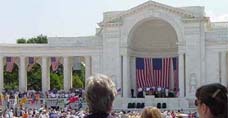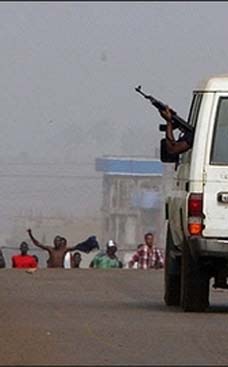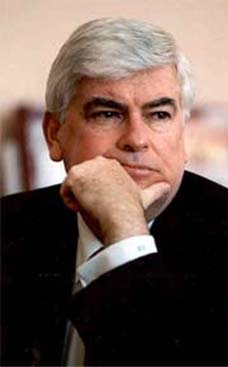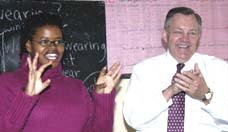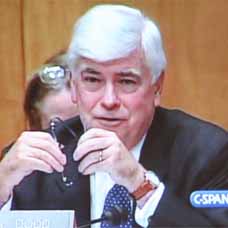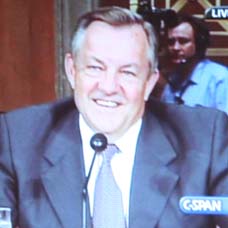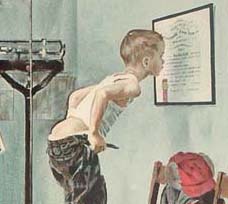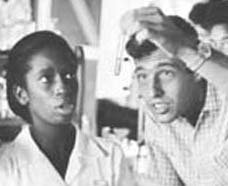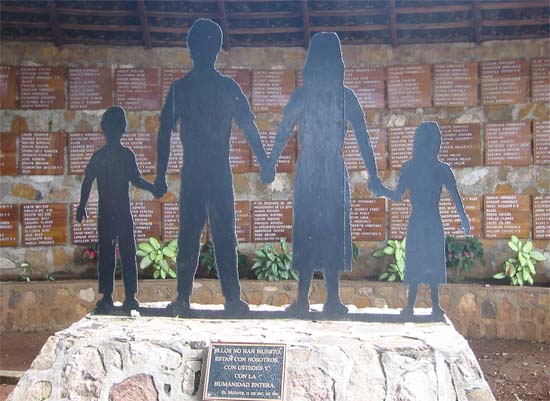
On the afternoon of December 10, 1981, units of the Salvadoran army's Atlacatl Battalion (named after a famous indigenous fighter that battled the Spanish troops for El Salvador) arrived at the remote village of El Mozote after a clash with guerrillas in the vicinity. The Atlacatl was a "Rapid Deployment Infantry Battalion", specially trained for counter-insurgency warfare. It was the first unit of its kind in the Salvadoran armed forces and was trained by US military advisors at the beginning of 1981. Its mission, Operación Rescate ("Operation Rescue"), was to eliminate the rebel presence in a small region of northern Morazan, where the FMLN had a camp and a training center. El Mozote consisted of about twenty houses situated on open ground around a square. Facing onto the square was a church and, behind it, a small building known as "the convent", used by the priest to change into his vestments when he came to the village to celebrate mass. Near the village was a small schoolhouse.
Early the next morning, the soldiers reassembled the entire village in the square. They separated the men from the women and children and locked them in separate groups in the church, the convent, and various houses. During the morning, they proceeded to interrogate, torture, and execute the men in several locations. Around noon, they began taking the women and older girls in groups, separating them from their children and machine-gunning them after raping them. Girls as young as 12 were raped, under the pretext of them being supportive of the guerillas. Finally, they killed the children. A group of children who had been locked in the church and its convent were shot through the windows. After killing the entire population, the soldiers set fire to the buildings.
What made the Morazan massacre stories so threatening was that they repudiated the fundamental moral claim that undergirded US policy. They suggested that what the United States was supporting in Central America was not democracy but repression. They therefore threatened to shift the political debate from means to ends, from how best to combat the supposed Communist threat — send US troops or merely US aid? — to why the United States was backing state terrorism in the first place.
El Mozote massacre
El Mozote massacre
Caption: Memorial to the victims of the Mozote Massacre
From Wikipedia, the free encyclopedia
Jump to: navigation, search
The El Mozote Massacre took place in the village of El Mozote, in Morazán department, El Salvador, on December 11, 1981, when Salvadoran armed forces killed an estimated 900 civilians in an anti-guerrilla campaign. It is reputed to be the worst such atrocity in modern Latin American history.
The massacre was both a low point and a turning point in the civil war that ravaged this Central American country between the late 1970s and early 1990s. As news of the massacre slowly emerged, the Reagan administration in the United States dismissed it as FMLN propaganda because it seriously undermined efforts by the U.S. government to bolster the human rights image of the Salvadoran government, which the US was supporting with large amounts of military aid[1].
The evening before
On the afternoon of December 10, 1981, units of the Salvadoran army's Atlacatl Battalion (named after a famous indigenous fighter that battled the Spanish troops for El Salvador) arrived at the remote village of El Mozote after a clash with guerrillas in the vicinity. The Atlacatl was a "Rapid Deployment Infantry Battalion", specially trained for counter-insurgency warfare. It was the first unit of its kind in the Salvadoran armed forces and was trained by US military advisors at the beginning of 1981. Its mission, Operación Rescate ("Operation Rescue"), was to eliminate the rebel presence in a small region of northern Morazan, where the FMLN had a camp and a training center. El Mozote consisted of about twenty houses situated on open ground around a square. Facing onto the square was a church and, behind it, a small building known as "the convent", used by the priest to change into his vestments when he came to the village to celebrate mass. Near the village was a small schoolhouse.
Upon arrival, the soldiers found not only the residents of the village but also campesinos who had sought refuge from the surrounding area. The soldiers ordered everyone out of their houses and into the square. They made them lie face down, searched them, and questioned them about the guerrillas. They then ordered the villagers to lock themselves in their houses until the next day, warning that anyone coming out would be shot. The soldiers remained in the village during the night.
December 11 and 12
Early the next morning, the soldiers reassembled the entire village in the square. They separated the men from the women and children and locked them in separate groups in the church, the convent, and various houses.
During the morning, they proceeded to interrogate, torture, and execute the men in several locations. Around noon, they began taking the women and older girls in groups, separating them from their children and machine-gunning them after raping them. Girls as young as 12 were raped, under the pretext of them being supportive of the guerillas. Finally, they killed the children. A group of children who had been locked in the church and its convent were shot through the windows. After killing the entire population, the soldiers set fire to the buildings.
The soldiers remained in El Mozote that night. The next day, they went to the village of Los Toriles, 2 km away. Several of the inhabitants managed to escape. The others — men, women and children — were taken from their homes, lined up, and shot.
Related activities
Clashes had taken place on December 9 between government troops and the guerrillas, when a company of the Atlacatl entered the town of Arambala. They rounded up the villagers in the town square and separated the men from the women and children. They locked the women and children in the church and ordered the men to lie face down in the square. A number of men were accused of being guerrilla collaborators, and they were tied up, blindfolded and tortured. Residents later found the bodies of three of them, stabbed to death.
The day before the El Mozote massacre, on December 10, Atlacatl had rounded up residents in the main square of Cumaro canton; no one was killed.
Members of the Atlacatl Battalion repeated similar actions in La Joya canton on December 11, in the village of La Rancheria on December 12, and in the village of Jocote Amarillo and Cerro Pando canton on 13 December.
Aftermath
The victims at El Mozote were left unburied. During the weeks that followed the bodies were seen by many people who passed by there.
The guerrillas' clandestine radio station began broadcasting reports of a massacre of civilians in the area. On December 31, the FMLN issued "a call to the International Red Cross, the OAS Human Rights Commission, and the international press to verify the genocide of more than 900 Salvadorans" in and around El Mozote. Reporters started pushing for evidence.
Officials from the US embassy in San Salvador played down the reports and were unwilling to visit the site because of safety concerns.
The FMLN had a sophisticated sense of how to use the media and it independently smuggled two reporters from two of the most prominent newspapers in the US, Raymond Bonner of the New York Times, Alma Guillermoprieto of the Washington Post, together with photojournalist Susan Meiselas, to the site approximately a month after the massacre took place.
News reports
News of the massacre first appeared in the media on January 27, 1982, in reports that were simultaneously published by the Times and the Post. Bonner wrote in the Times of seeing "the charred skulls and bones of dozens of bodies buried under burned-out roofs, beams, and shattered tiles".
Guillermoprieto, who visited the village separately a few days later, wrote of "dozens of decomposing bodies still seen beneath the rubble and lying in nearby fields, despite the month that has passed since the incident". In what had once been a white-washed church, "countless bits of bones — skulls, rib cages, femurs, a spinal column — poked out of the rubble".
Both reporters spoke to a woman named Rufina Amaya, who said she had escaped in the confusion and hidden in a tree. She told the reporters that the soldiers killed her husband, her nine-year-old son, and her three daughters, aged five, three, and eight months. The soldiers set piles of bodies on fire, she said, then left.
The villagers gave Bonner a list of 733 names — mostly children, women, and old people — all of whom, they claimed, had been murdered by government soldiers.
Backlash
Seeing the conflict as critical in its determination to prevent communist encroachment in Central America, the Reagan administration was determined to give the Salvadoran government military assistance in defeating the FMLN insurgency. This was seriously complicated by the reports from El Mozote, which appeared just as a new round of debate over the huge flow of money and arms being sent to El Salvador's armed forces was getting underway. Correspondingly, the reports drew immediate fire from Reagan administration officials and others on the American political right. Salvadoran army and government leaders said no such massacre had taken place and officials of the Reagan administration dismissed the reports "as gross exaggerations".
Accuracy in Media, the conservative press watch organization, charged the newspapers and the reporters with conspiring to hold their stories until late January, just before President Reagan was required to certify that El Salvador's military forces were making progress in human rights in order to continue the subsidies. The reporters denied the charge.
Thomas Enders, then Assistant Secretary of State for Inter-American Affairs, attacked Bonner and Guillermoprieto before a congressional committee, saying that although there had been a firefight between the army and the guerrillas in the area, "no evidence could be found to confirm that government forces systematically massacred civilians". On February 8, Elliott Abrams, Assistant Secretary of State for Human Rights and Humanitarian Affairs, told a Senate committee that the reports of hundreds of deaths at El Mozote "were not credible", and that "it appears to be an incident that is at least being significantly misused, at the very best, by the guerrillas". Abrams implied that reports of a massacre were simply FMLN propaganda.
In February, in a lengthy editorial titled "The Media's War," the Wall Street Journal critiqued US press coverage of El Salvador, singling out Bonner as being "overly credulous", and accusing the Times of closing ranks "behind a reporter out on a limb". The Journal warned that the debate in Congress was being distorted from reality by Bonner's and Guillermoprieto's "overly credulous" reports of the massacre. It cited Enders' denial and charged that because the two reporters had visited El Mozote under the protection of guerrilla guides, "this was a propaganda exercise". In Time Magazine, William A. Henry III wrote a month later: "An even more crucial if common oversight is the fact that women and children, generally presumed to be civilians, can be active participants in guerrilla war. New York Times correspondent Raymond Bonner underplayed that possibility, for example, in a much-protested January 27 report of a massacre by the army in and around the village of Mozote."
Although attacked less vigorously than Bonner, Guillermoprieto was also a target of criticism. A Reagan official wrote a letter to the Post claiming that Guillermoprieto had once worked for a communist newspaper in Mexico. She denied ever working for any newspaper in Mexico, and told that to editor Ben Bradlee when he questioned her in the newsroom.
In June 1982, after the Senate Foreign Relations Committee proposed cutting $100 million in military aid to El Salvador, US Ambassador Deane Hinton traveled to Washington to try to prevent the cutback. While he was there, he went out of his way to attack Bonner, particularly over the reporter's stories about the failure of El Salvador's land-reform program. Hinton denounced Bonner as an "advocate journalist".
In late July, Accuracy in Media devoted an entire edition of its AIM Report to Bonner. Its editor, Reed Irvine, declared that "Mr. Bonner had been worth a division to the communists in Central America". Irvine made insinuations about Bonner's political sympathies, noting that he had once worked for Ralph Nader, omitting that he had been a Marine Corps officer in Vietnam, and all but calling him a communist agent.
That August, Bonner was ordered to return to New York; he subsequently took a leave of office and left the newspaper shortly thereafter. The Post also recalled Guillermoprieto, promoting her to a staff position, and assigning her to cover suburban Washington. Guillermoprieto left the paper two years later.
In the course of the year, a number of Salvadoran human rights organizations denounced the massacre. The Salvadoran authorities categorically denied that a massacre had taken place. No judicial investigation was launched and there was no word of any investigation by the government or the armed forces. Bonner later published a book on his experiences, Weakness and Deceit: U.S. Policy and El Salvador (1984), but in the intervening years, the El Mozote story was slowly buried.
The Atlacatl Battalion went on to commit many more atrocities, including, nine years later, the murder of six Jesuits, their cook and her daughter, in November 1989. Among them the scholars Ignacio Ellacuría, Ignacio Martín-Baró and Segundo Montes. Although the perpetrators tried to disguise it as the work of left-wing rebels, it soon became obvious that Atlacatl had been behind it, to universal condemnation. However, after the El Mozote massacre, the Salvadoran army as a whole moved towards gentler "hearts and minds" strategies in its attempts to undermine support for the FMLN.
Vindication
On 26 October 1990, a criminal complaint against the Atlacatl Battalion was filed by Pedro Chicas Romero, of La Joya, who had hidden in a cave above the hamlet as the soldiers killed his family and neighbors, and judicial proceedings were instituted. One of the first witnesses called to give testimony was Rufina Amaya, and the judge ordered remains to be exhumed.
In 1992, as part of the peace settlement established by the Chapultepec Peace Accords signed in Mexico City on January 16 of that year, a United Nations-sanctioned Truth Commission investigating human rights abuses committed during the war supervised the exhumations of the El Mozote remains by an Argentinian team of forensic specialists from 13 and 17 November 1992.
The Salvadoran Minister of Defense and the Chief of the Armed Forces Joint Staff informed the Truth Commission that they had no information that would make it possible to identify the units and officers who participated in Operación Rescate. They claimed that there were no records for the period.
The Truth Commission stated in its final report:
There is full proof that on 11 December 1981, in the village of El Mozote, units of the Atlacatl Battalion deliberately and systematically killed a group of more than 200 men, women and children, constituting the entire civilian population that they had found there the previous day and had since been holding prisoner.
It added:
there is [also] sufficient evidence that in the days preceding and following the El Mozote massacre, troops participating in "Operation Rescue" massacred the non-combatant civilian population in La Joya canton, in the villages of La Rancheria, Jocote Amatillo y Los Toriles, and in Cerro Pando canton.
The Times takes another look
On October 22, 1992, a headline on the front page of The New York Times announced "Salvador Skeletons Confirm Reports of Massacre in 1981". Reporter Tim Golden began:
In a small rectangular plot among the overgrown ruins of a village here, a team of forensic archeologists has opened a window on El Salvador's nightmarish past. Nearly 11 years after American-trained soldiers were said to have torn through El Mozote and surrounding hamlets on a rampage in which at least 794 people were killed, the bones have emerged as stark evidence that the claims of peasant survivors and the reports of a couple of American journalists were true.
A similar article, by Douglas Farah, appeared the same day in The Washington Post.
In 1993, a special State Department panel that examined the actions of U.S. diplomats vis-a-vis human rights in El Salvador concluded that "mistakes were certainly made... particularly in the failure to get the truth about the December 1981 massacre at El Mozote."
That year, American journalist Mark Danner published an article in the December 6 issue of The New Yorker. His article, "The Truth of El Mozote", caused widespread consternation, for it rekindled the debate regarding the US role in Central America during the violence-torn 1970s and 1980s. He subsequently expanded the article into a book, The Massacre at El Mozote (1994).
In a prefatory remark, Danner wrote:
That in the United States it came to be known, that it was exposed to the light and then allowed to fall back into the dark, makes the story of El Mozote — how it came to happen and how it came to be denied — a central parable of the Cold War.
In his study of the media and the Reagan administration, On Bended Knee, American author Mark Hertsgaard wrote of the significance of the first reports of the massacre:
What made the Morazan massacre stories so threatening was that they repudiated the fundamental moral claim that undergirded US policy. They suggested that what the United States was supporting in Central America was not democracy but repression. They therefore threatened to shift the political debate from means to ends, from how best to combat the supposed Communist threat — send US troops or merely US aid? — to why the United States was backing state terrorism in the first place.
Case reopened
On March 7, 2005, the OAS's Inter-American Commission on Human Rights reopened an investigation into the El Mozote massacre because of new evidence found by a team of Argentine forensic anthropologists in 2003. Recent efforts by lawyers in El Salvador to reopen the case, which was shelved in 2000, have repeatedly failed, even after a court ruling that year stripped protection under the national amnesty law from suspects in the most egregious human rights violations.
If the Commission on Human Rights finds enough evidence tying the Salvadoran government to the killings, the case will go to the Inter-American Court. Though it is unlikely that the court's decision would result in jail time for those involved, the court could demand that the government conduct an investigation of the incident and require payment of reparations to the families of those who died or disappeared.[2]
In a January 2007 report in the Washington Post, a former Salvadoran soldier, José Wilfredo Salgado, told of returning to El Mozote several months after the massacre and collecting the skulls of the youngest victims, whose remains were exposed by recent rains, for "candleholders and good-luck charms." [3]
